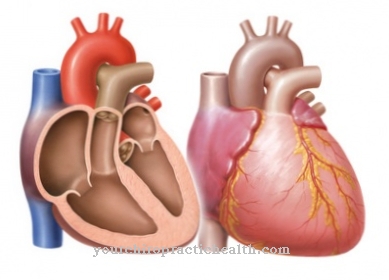At the Abdominal reflex it is a self-reflex of the human body, which leads to the involuntary contraction of the abdominal muscles. The function of the abdominal wall reflex is to protect the abdominal muscle from passive overstretching and thereby avert damage to it. Failure to do so may indicate damage to the pyramidal tract, for example as a result of a stroke.
What is the abdominal wall reflex?

The abdominal wall reflex is a human self-reflex. Self-reflexes are characterized by the fact that irritation and reaction take place in the same organ.
Neurophysiology, which deals with the mechanisms of the human nervous system, describes a reflex that is neuronally interconnected in a special way: projections of the nerve cell, the dendrites, receive the stimulating signal. These specialized dendrites of sensory nerve cells are called afferent dendrites, derived from the Latin 'affere', which means 'to carry' or 'to carry'.
In the case of a self-reflex, a so-called Ia afference transmits this nerve signal to a motor neuron via a single switching point. Accordingly, two nerve cells and an interface (synapse) are involved in the information transmission of the triggering stimulus.
The neurosciences refer to efferent nerve cells as motor neurons, derived from the Latin term 'efferre', 'carry out'. In contrast to the afferent neurons, which carry information to the nervous system, the efferent nerves carry commands from the nervous system to the muscles. This efferent signal causes the corresponding muscle to contract, which in this case results in the abdominal wall reflex.
As with all self-reflexes, the abdominal wall reflex proceeds without the involvement of the central nervous system. The human body can therefore not consciously trigger or suppress the movement.
Function & task
Passive stretching of the abdominal muscle triggers the abdominal wall reflex. Special sensory nerve cells located in the muscle detect the stretch. The mechanical stimulation of the dendrites (afferents) leads to a change in the electrical potential of the neuron. This in turn causes a depolarization of the cell and causes it to produce a chemical signal: It releases certain messenger substances, so-called neurotransmitters, into the synaptic gap between the sensory nerve cell and the next neuron. The following nerve cell records the chemical irritation with the help of the receptors on its dendrites. In this way, the nerve signal is transmitted from cell to cell.
Various mechanical stimuli are able to trigger the abdominal wall reflex on one or both sides. A push against the costal arch can provoke the abdominal wall reflex as well as a blow against the iliac crest. Even if the abdominal muscle above the pubic bone is stretched too much passively, the human body automatically triggers the abdominal wall reflex.
One of the functions of the reflex is to protect the muscle from overstretching. Muscle fibers are elastic tissue that behaves flexibly and can be stretched to a certain extent. However, this elasticity is limited. If the muscle is slowly, gradually overstretched, only individual fine fibers of the muscle will tear. The effects of such a slight overstretching are uncomfortable for the person concerned, but only manifest themselves in the form of the well-known sore muscles and have no far-reaching health consequences. However, increasing tension on the muscle fibers can tear entire muscle fibers and even the muscle as a whole.
The abdominal wall reflex also has a second important protective function: It protects the organs of the abdominal cavity from possible damage from blows or falls. The contraction stiffens the abdominal muscles and thus forms a natural shield to shield the organs from mechanical stimuli. However, this protection is only sufficient to a certain extent. In the event of a traffic accident or intentionally inflicted violence, the protection provided by the abdominal wall reflex is insufficient. One consequence is often injuries to the internal organs in the abdomen.
During a medical examination, doctors usually place two fingers on one hand on the abdominal muscle and briefly tap the back of the hand with the other hand or the reflex hammer. This allows them to determine whether the abdominal wall reflex is triggered as expected. Its absence may indicate a neurological or other disease.
Illnesses & ailments
A lack of abdominal wall reflex can indicate various diseases. However, it is not the only symptom of this, and medical professionals cannot always attribute its absence to a single cause. If irritation of the abdominal muscle does not lead to the abdominal wall reflex, it may indicate damage to the pyramidal tract. The pyramidal tract is part of the pyramidal nervous system, which in its entirety controls the movements of the human body.
The pyramidal tract begins at the elongated spinal cord (medulla oblongata), which is part of the brain, and continues across the spinal cord, where most of the nerve fibers cross. The motor neurons involved in the abdominal wall reflex are also located there. They designate neurosciences with the code Th6-L1. For this reason, damage to the pyramidal tract affects the abdominal wall reflex, among other things. In particular, if the abdominal muscle reacts to an irritation with the abdominal wall reflex on only one side, damage to the pyramidal tract is likely.
A stroke (apoplexy) has the potential to cause this lesion. A stroke is damage to the brain that often affects other parts of the nervous system and is caused by a poor blood supply to the brain. The absence of the abdominal wall reflex is therefore a serious symptom that requires further clinical diagnosis by a doctor.













.jpg)

.jpg)
.jpg)











.jpg)